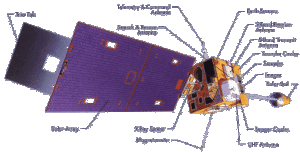What is an Attitude Control System?
An attitude control system (ACS) is responsible for managing the orientation of a spacecraft or satellite in space. Unlike position control, which focuses on the spacecraft’s location, attitude control ensures that the spacecraft is oriented correctly. This is crucial for accurate data collection, communication, and proper functioning of payloads. ACS is essential for all types of space missions, from Earth observation satellites to deep-space exploration.

Components of an Attitude Control System
An attitude control system integrates various components that work together to maintain or change the orientation of a spacecraft.
1. Sensors
Attitude sensors are used to measure the spacecraft’s orientation relative to Earth, the Sun, or other celestial objects. Common sensors include star trackers, sun sensors, magnetometers, and gyroscopes. These sensors provide the necessary data to determine the spacecraft’s current attitude.
2. Actuators
Actuators are responsible for adjusting the spacecraft’s orientation. Common actuators include reaction wheels, control moment gyroscopes (CMGs), and magnetic torquers. These devices apply torques to the spacecraft to change its attitude based on commands from the control system.
3. Control Algorithms
Control algorithms process the data from the sensors and determine the necessary adjustments to the spacecraft’s orientation. The most common control methods include PID (Proportional-Integral-Derivative) controllers, adaptive control, and model-based control techniques, which help achieve precise attitude adjustments.
Methods of Attitude Control
There are several methods used to control a spacecraft’s attitude, each with its advantages and specific applications.
1. Momentum Wheels
Momentum wheels, or reaction wheels, are the most commonly used actuators for fine attitude control in satellites. By spinning at different speeds, they generate torque, allowing precise control over the spacecraft’s orientation.
2. Control Moment Gyroscopes (CMGs)
Control moment gyroscopes are often used in larger spacecraft and space stations. They work by using gyroscopic forces to generate torque, providing high-performance attitude control with minimal fuel consumption.
3. Magnetic Torquers
Magnetic torquers use the Earth’s magnetic field to generate torque on the spacecraft. They are typically used in combination with other actuators and are more commonly found in small spacecraft, such as CubeSats.
Applications of Attitude Control Systems
Attitude control systems are critical for a wide range of space missions, including:
1. Earth Observation Satellites
For Earth observation satellites, accurate attitude control is essential for ensuring that imaging instruments are pointed correctly at the Earth’s surface. Any deviation in orientation can lead to blurry or inaccurate data.
2. Communication Satellites
Communication satellites rely on precise attitude control to maintain alignment with ground stations and other satellites. This ensures continuous data transmission and proper functioning of the communication payload.
3. Space Exploration Missions
For deep-space exploration, spacecraft must maintain precise attitude control to keep instruments and cameras aligned with their targets. This is essential for gathering scientific data and images from distant planets, moons, or asteroids.
Challenges in Attitude Control
While attitude control systems are vital, they also face several challenges, including:
1. Power Consumption
The actuators used in ACS, such as reaction wheels and CMGs, can consume a significant amount of power, which can limit the overall efficiency of the spacecraft. Advances in energy-efficient actuators and control algorithms are helping to mitigate this issue.
2. Redundancy and Reliability
In critical missions, redundancy is key to ensuring that the attitude control system remains operational even if one component fails. This requires careful design and the use of backup systems to maintain spacecraft stability.
3. Spacecraft Environment
The space environment, including radiation and temperature extremes, can affect the performance of sensors and actuators. Engineers must design systems that can withstand these harsh conditions while maintaining high performance.
Future of Attitude Control Systems
With advancements in AI, machine learning, and new materials, the future of attitude control systems looks promising. Next-generation systems aim to improve the efficiency, reliability, and precision of spacecraft orientation. These advancements will be crucial for the growing number of space missions, particularly in areas like deep-space exploration and large-scale satellite constellations.
Interested in more information on attitude control technologies and their applications?
Click here to explore the latest trends and innovations in attitude control systems.
